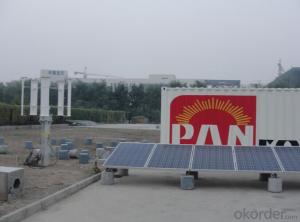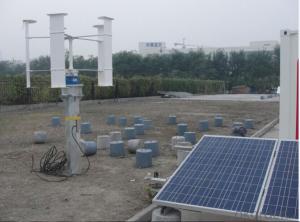Wind-PV(Diesel)Hybrid Power System
- Loading Port:
- Tianjin
- Payment Terms:
- TT OR LC
- Min Order Qty:
- 2 set
- Supply Capability:
- 30 set/month
OKorder Service Pledge
OKorder Financial Service
You Might Also Like
Specification List
Name | Specification | Quantity | |
1 | Containter | 20*8*8.6ft | 1 |
2 | Solar Module | 240W | 30 |
3 | Wind Generator | 500W | 2 |
4 | Battery | 12V120Ah | 20 |
5 | Controller | 120V/40A | 1 |
6 | Inverter | 6000W/AC230V | 1 |
7 | Diesel | 5000W/AC230V | 1 |
8 | Air Conditioner | 1000W | 1 |
9 | Cables | — | — |
10 | Others | — | — |
2.System Principle
3.System Advantage
Extend battery life |
Reduce the dependence of climate system |
24 hour uninterrupted power supply |
Low maintenance cost |
4.Product Specification
(A) Solar Module
Rated Power | 240W |
Vmppt | 29.4V |
Imppt | 8.17A |
Voc | 37.4V |
Isc | 8.55A |
Power Temp.Coeff(/℃) | -0.47% |
Ambient Temp | -40-85℃ |
Power Tolerance | ±3% |
NOCT | 46℃±2 |
(B) Battery
Rated Voltage | 240V | |
Rated Capacity (C10) | 120Ah | |
Weight | 35kg | |
Dimension | Lenth | 406mm |
Width | 174mm | |
Height | 209mm | |
Capacity | C120 | 150Ah |
C30 | 138Ah | |
C10 | 120Ah | |
C1 | 78Ah | |
Overcharging Protect Voltage | 14.4V/12V | |
Cut off Voltage | 10.8V/12V | |
(C) Wind Generator
Rated Power | 500W |
Rated Wind Speed | 13m/s |
Cut-in Speed | 4m/s |
Cut-out Speed | 25m/s |
Survival Wind Speed | 45m/s |
Mill Diameter | 1.36m |
Mill Height | 1.05m |
Mill Weight | 90kg |
Rated Voltage | AC 42V |
Rated Current | AC 6.9A |
Protection Level | IP54 |
(D) Controller
Solar Controller
Rated Power | 7.2KW |
MPPT | DC120V-350V |
Rated Voltage | DC 120V |
Rated Current | 60A |
Conversion Efficiency | ≥93% |
Overload Capacity | 120% output, 30mins |
Wind Generator Controller
Rated Power | 500W |
Maximum Power | 750W |
Rated Voltage | AC 42V |
E) Inverter
Rated Power | 6000W |
Rated Input Voltage | DC 120V |
Rated Input Current | DC 50A |
Rated Output Voltage | AC 230V |
Rated Frequency | 50Hz |
Rated Current | AC 26.1A |
Output Voltage Precision(V) | 230±5% |
Output Frequency Precision(Hz) | 50±0.05 |
Overload Capacity | 120%, 60S; 150%, 10S |
Inverter Efficiency | 80% |
- Q:Can solar energy systems be used in areas with high levels of dust or debris?
- Yes, solar energy systems can be used in areas with high levels of dust or debris. However, regular maintenance and cleaning may be required to ensure optimal performance of the solar panels.
- Q:What is the impact of air pollution on the performance of solar panels?
- Solar panel performance can be significantly affected by air pollution. One of the main ways in which it affects them is by diminishing the amount of sunlight that reaches the panels. Sunlight can be scattered and absorbed by air pollution, such as smog and particulate matter, resulting in a decrease in the solar energy absorbed by the panels. This, in turn, reduces the overall efficiency and power output of the panels. Furthermore, a layer of dust, dirt, and other pollutants can be deposited on the surface of solar panels due to air pollution. This layer obstructs and absorbs sunlight, further reducing the amount of energy that can be collected. Additionally, the accumulation of these pollutants acts as a barrier that hampers the transmission of sunlight to the solar cells, thus decreasing the panels' efficiency. Moreover, air pollution can cause the corrosion of solar panel surfaces. Pollutants like sulfur dioxide and nitrogen oxides can react with moisture in the air, forming acidic compounds. Over time, these compounds gradually deteriorate the protective coatings on the panels and damage the cells, leading to a reduction in performance and lifespan. Overall, the impact of air pollution on solar panels is significant. It diminishes the amount of harvested sunlight, lowers the efficiency and power output of the panels, and can cause damage and deterioration over time. Therefore, it is crucial to consider the effects of air pollution during the design and installation of solar panels to ensure optimal performance and longevity.
- Q:What is the average payback period for a solar energy system?
- The average payback period for a solar energy system varies depending on various factors such as the initial cost of the system, location, energy usage, available incentives, and financing options. However, on average, it typically ranges from 5 to 10 years.
- Q:How do solar energy systems impact the efficiency of air conditioning systems?
- Solar energy systems can significantly impact the efficiency of air conditioning systems by providing a clean and renewable source of power. By harnessing solar energy, air conditioning units can operate without relying solely on grid electricity, reducing their carbon footprint and energy costs. Additionally, solar-powered air conditioning systems can operate during peak demand periods when electricity rates are typically higher, further enhancing their efficiency.
- Q:Can a solar energy system be installed on a church or religious building?
- Yes, a solar energy system can be installed on a church or religious building. In fact, many religious organizations have started to embrace solar energy as a sustainable and environmentally friendly solution to reduce their carbon footprint and lower their energy costs. Installing solar panels on the roof of a church or religious building can generate clean and renewable energy, which can be used to power the facility and reduce its reliance on traditional energy sources. Additionally, by going solar, religious organizations can set an example for their communities and inspire others to adopt clean energy practices.
- Q:Can solar energy systems be used in areas with limited access to solar energy training programs?
- Yes, solar energy systems can still be used in areas with limited access to solar energy training programs. While training programs can provide valuable knowledge and skills, there are resources available online, in books, and through self-study that can help individuals learn about solar energy systems and their installation and maintenance. Additionally, local experts or professionals already working in the field can provide guidance and support to those interested in utilizing solar energy systems in such areas.
- Q:Can solar energy systems be used in rural areas without access to the grid?
- Solar energy systems are definitely able to be utilized in rural areas that lack access to the grid. In reality, solar power can serve as an ideal solution for off-grid locations as it captures energy from the sun and converts it into electricity without relying on conventional power sources. Sunlight can be captured by installing solar panels on rooftops or in open spaces, which can then be converted into usable electricity through an inverter system. This electricity can be utilized to power a wide range of appliances and devices, providing electricity for lighting, charging mobile phones, operating small appliances, and even powering agricultural equipment or water pumps. Furthermore, any excess energy generated during the day can be stored in batteries for use during nighttime or overcast days. Solar energy systems present a sustainable and dependable electricity source for rural communities, decreasing their reliance on costly and unreliable generators that run on fossil fuels or traditional power grids.
- Q:Can a solar energy system be installed on a flat roof?
- Yes, a solar energy system can be installed on a flat roof. In fact, flat roofs are often considered ideal for solar panel installations due to their unobstructed space and ease of installation.
- Q:Can a solar energy system be used in areas with limited sunlight?
- Yes, a solar energy system can still be used in areas with limited sunlight. While it is true that solar panels produce the most electricity when exposed to direct sunlight, they can still generate power even in areas with limited sunlight. Solar panels can still produce electricity on cloudy days or during periods of low sunlight, albeit at a reduced efficiency. Additionally, advancements in solar panel technology have made it possible for panels to capture and convert even diffuse sunlight, which means they can still function in areas with limited direct sunlight. Moreover, solar energy systems can be designed to include energy storage solutions such as batteries, allowing for the storage of excess energy generated during periods of peak sunlight for use during periods of limited sunlight. This ensures that solar energy can still be utilized in areas with limited sunlight, making it a viable and sustainable energy solution for various regions around the world.
- Q:Can solar energy systems be used for powering electric plane systems?
- Solar energy systems have the ability to power electric plane systems. The concept of using solar power for aviation has gained considerable attention in recent years. In order to capture sunlight and convert it into electricity, solar panels can be installed on the wings and fuselage of an aircraft. This electricity can then be utilized to power various systems on the plane, including navigation, communication, lighting, and auxiliary power units. While it is currently not practical to solely rely on solar power for the main propulsion of a commercial plane due to the limited energy density of solar panels, solar energy can still play a valuable role in reducing overall energy consumption in aircraft. By utilizing solar power for auxiliary systems, electric planes can significantly decrease their dependence on traditional fossil fuel-based power sources. Experimental and small-scale projects have already shown promising results in solar-powered electric planes. For example, Solar Impulse 2, a solar-powered aircraft, successfully completed a round-the-world journey in 2016, highlighting the potential of solar energy in aviation. NASA is also actively exploring the application of solar energy in their electric aircraft research. However, there are still obstacles to overcome in order to fully integrate solar energy systems into commercial aviation. The efficiency and weight of solar panels need to be enhanced to generate sufficient power for larger aircraft. Additionally, advanced energy storage technologies must be developed to store excess solar energy for use during low-sunlight conditions or nighttime flights. Despite these challenges, the potential advantages of utilizing solar energy in aviation are significant. Solar-powered electric planes have the capability to reduce carbon emissions and decrease reliance on fossil fuels, ultimately leading to a more sustainable and environmentally friendly aviation industry. As technology continues to advance, the integration of solar energy systems into electric plane systems will likely become more feasible and widespread.
1. Manufacturer Overview |
|
|---|---|
| Location | |
| Year Established | |
| Annual Output Value | |
| Main Markets | |
| Company Certifications | |
2. Manufacturer Certificates |
|
|---|---|
| a) Certification Name | |
| Range | |
| Reference | |
| Validity Period | |
3. Manufacturer Capability |
|
|---|---|
| a)Trade Capacity | |
| Nearest Port | |
| Export Percentage | |
| No.of Employees in Trade Department | |
| Language Spoken: | |
| b)Factory Information | |
| Factory Size: | |
| No. of Production Lines | |
| Contract Manufacturing | |
| Product Price Range | |
Send your message to us
Wind-PV(Diesel)Hybrid Power System
- Loading Port:
- Tianjin
- Payment Terms:
- TT OR LC
- Min Order Qty:
- 2 set
- Supply Capability:
- 30 set/month
OKorder Service Pledge
OKorder Financial Service
Similar products
New products
Hot products
Related keywords





























